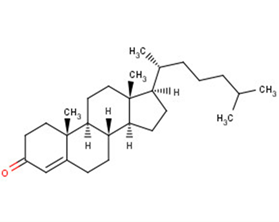
Cholestenone
CAS No. 601-57-0
Cholestenone( (+)-4-Cholesten-3-one )
Catalog No. M19974 CAS No. 601-57-0
4-Cholesten-3-one is an intestinal metabolite of Cholesterol. It shows an anti-obesity effect on animals.
Purity : >98% (HPLC)
 COA
COA
 Datasheet
Datasheet
 HNMR
HNMR
 HPLC
HPLC
 MSDS
MSDS
 Handing Instructions
Handing Instructions
| Size | Price / USD | Stock | Quantity |
| 500MG | 52 | In Stock |


|
| 1G | Get Quote | In Stock |


|
Biological Information
-
Product NameCholestenone
-
NoteResearch use only, not for human use.
-
Brief Description4-Cholesten-3-one is an intestinal metabolite of Cholesterol. It shows an anti-obesity effect on animals.
-
Description4-Cholesten-3-one is an intestinal metabolite of Cholesterol. It shows an anti-obesity effect on animals.
-
In Vitro——
-
In Vivo——
-
Synonyms(+)-4-Cholesten-3-one
-
PathwayOthers
-
TargetOther Targets
-
RecptorOthers
-
Research Area——
-
Indication——
Chemical Information
-
CAS Number601-57-0
-
Formula Weight384.64
-
Molecular FormulaC27H44O
-
Purity>98% (HPLC)
-
SolubilityEthanol: 2 mg/mL
-
SMILESCC(C)CCC[C@@H](C)[C@H]1CC[C@H]2[C@@H]3CCC4=CC(=O)CC[C@]4(C)[C@H]3CC[C@]12C
-
Chemical Name——
Shipping & Storage Information
-
Storage(-20℃)
-
ShippingWith Ice Pack
-
Stability≥ 2 years
Reference
1.Rosenheim O et al. The mechanism of coprosterol formation in vivo: 1. Cholestenone as an intermediate. Biochem J. 1943 Oct;37(4):513-4.
molnova catalog



related products
-
Naringin 6-acetate
The peels of Citrus maxima.
-
7-O-ethyl-morronisid...
7-O-ethyl-morroniside is a natural product from Lonicera morrowii.
-
Chromostatin, bovine
Chromostatin bovine is a chromogranin A (CGA) derivative peptide, which inhibits postassium or carbamoylcholine induced catecholamine release with an ID50 of 5 nM. Chromostatin bovine reduces calcium flux, enhances the desensitization process of the cholinergic-evoked secretory response and modulates the endocrine response associated with catecholamine.



 Cart
Cart
 sales@molnova.com
sales@molnova.com


